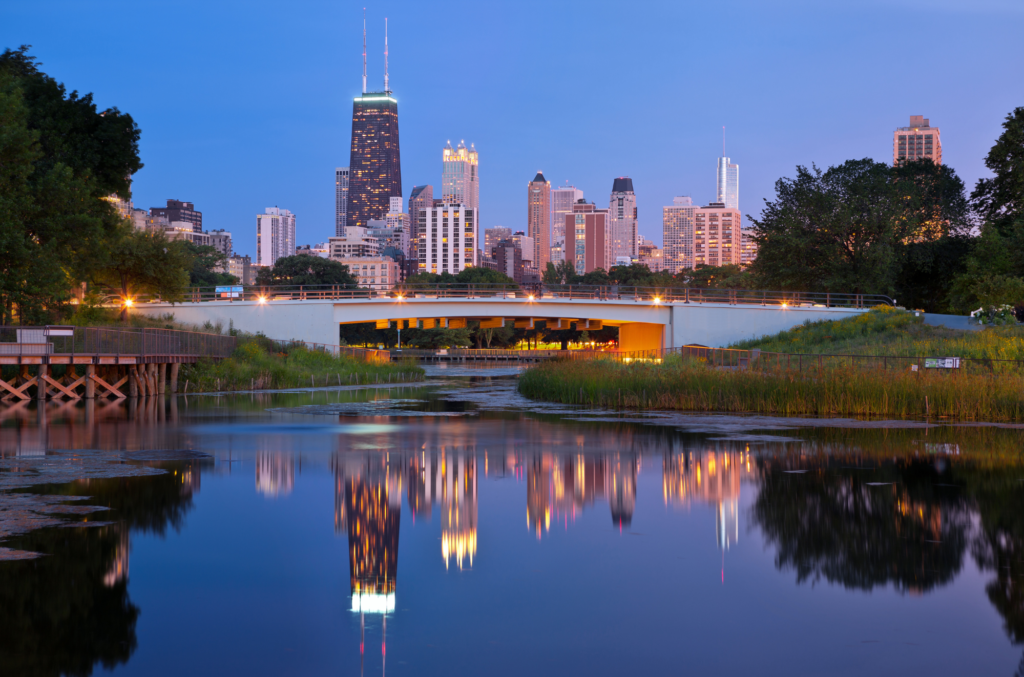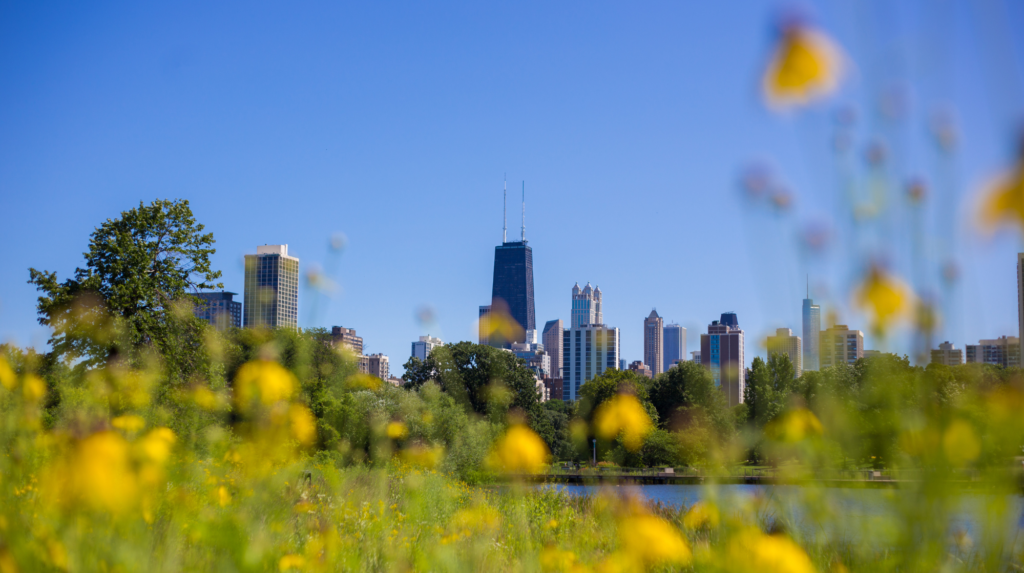
Iconic Chicago: Lincoln Park – The Ultimate Playground
Published on August 22, 2022
Our monthly series Iconic Chicago looks at some of the most famous locations in our city. We’ll explore the history of these places and why they have earned the love of residents and tourists alike. The latest installment of Iconic Chicago explores the history of Lincoln Park.
Next time you’re in Lincoln Park, take our scavenger hunt Lincoln Park’s Hidden Gems and the zoo.
If Grant Park is “Chicago’s Front Yard,” then Lincoln Park may be its ultimate playground. Spread out over 1,200 acres and across nearly seven miles of the lakefront, the park’s facilities include: six beaches, three boat harbors, a zoo, conservatory, golf course, nature preserves, theatre, museums, rowing lagoon, public art and statues, trails, and meadows, as well as fields and courts for nearly every sport you can think of–and so much more. It all starts just north of downtown Chicago.
The park’s history begins in 1837, shortly before Chicago’s incorporation as a city, when the lakefront between North Ave. and Asylum Pl. (now Webster Ave.) was reserved for a public cemetery. City Cemetery opened in 1843 but due to both the quality of the soil and the poor upkeep, it was quickly determined that the space was unfit for that purpose.
Still, the burials continued. Dr. John Rauch launched a public campaign to remove the cemetery, arguing that the proximity of the deceased to Lake Michigan posed a public health risk—particularly those who had died of infectious diseases. In 1860, the city agreed to turn the northern third of the land, about 60 acres which had yet to be used, into a park.
The burials stopped in 1866 and, by 1869, control of the land was transferred to the newly created Lincoln Park Commission, who quickly extended the northern boundary of the park to Diversey Ave.

The practice of disinterring the cemetery started in 1872 and took about five years, although it’s believed that not all the bodies were removed. As recently as 1968, skeletal remains were found in the park, when the Chicago History Museum was building a new parking lot. More bones were discovered a block away from the park’s southern border in 2008 and again in 2010. These days, only an 1858 tomb for the Couch family remains as a visible symbol of the park’s days as a cemetery, because the 50-ton monument was too expensive to move to a different location.
Although initially dubbed Cemetery Park, then Lake Park, the assassination of Abraham Lincoln in April 1865 led to it being renamed in memory of the slain president, who had a deep connection to Chicago. Swain Nelson, a landscape architect who had previously laid out Union Park, was awarded $200 to design the new park. His vision was for a man-made lagoon surrounded by tree-lined paths and a 35-foot hill called “Lookout Mountain.”
It didn’t take long for Lincoln Park to start growing. In 1868, New York’s Central Park gifted Chicago four swans that were subsequently housed in South Pond. More animals, including a bear, bison, wolves, deer and peacocks, were donated over the next five years and the Lincoln Park Zoo was born.
Working with his cousin, Olof Benson, Nelson refined his plans. Together, they designed a road along the park’s eastern side that opened in 1871. It was called Lake Shore Drive and, by 1875, it was extended to Oak St. and began attracting some of the city’s most prominent families. Today, the original stretch of Lake Shore Drive is Cannon Dr. and serves as Lincoln Park Zoo’s parking lot. The area above Fullerton Ave. came next, and it consisted mostly of North Pond and a hill called Mount Prospect.

Up to this point, Lincoln Park had consisted of existing land. But after a particularly harsh winter damaged the lakefront, the Commission decided to fill in 60 acres of the lake behind a series of breakwaters that were being constructed and add more parkland as well as the rowing lagoon, Diversey Harbor and the Outer Drive.
In the late 1880s, it was believed that the lake breezes could help cure children stricken with tuberculosis and other illnesses. The Chicago Daily News funded the Fresh Air Sanitarium in the park, which also provided health care and meals to local impoverished children. A new building opened on the site in 1920 and continued to serve 30,000 children each summer until it closed in 1939. It served as a recreational center for the USO during World War II, and in 1953 it re-opened as Theatre on the Lake. A $7 million renovation in 2017 modernized and enclosed the theater for year-round performances, with a restaurant, bar and outdoor patio added to the facility.
The park continued to evolve as the 19th century came to a close. A lily pool was built near the zoo in 1889. After falling into disrepair, it was fixed up in 1936 with a design by Alfred Caldwell, for whom the pool was named after another restoration in 2001. In the same area, four houses that comprise the Lincoln Park Conservatory were built between 1890 and 1895, as were the Formal Gardens.
The Chicago Academy of Sciences opened its new headquarters and museum in 1894. It was expanded and renamed the Peggy Notebaert Nature Museum in 1999.
The park’s first beach opened in 1895 near the sanitarium. It was intended exclusively for children, although women were given their own occasional days to enjoy in the lake.
The southward extension of Lake Shore Drive created more beaches, first at Oak St. and later at Ohio St. Both were eventually incorporated into Lincoln Park, with the Ohio St. Beach, just north of Navy Pier, now serving as the southern end of Lincoln Park.
In 1889, the City of Chicago annexed Lake View Township, expanding Lincoln Park further north. The Lincoln Park Commission also implemented a series of projects to fill in the lake and incorporate that area into the park, bringing new amenities. A six-hole golf course, later expanded to nine, opened just north of Diversey, right about the time that Diversey and Belmont Harbors were being completed. It was replaced in 1932 by the Waveland Golf Course, also knows as Sydney R. Marovitz Golf Course, named for the late parks commissioner.

The Great Depression led to the Lincoln Park Commission and Chicago’s 21 other park commissions to consolidate as the Chicago Park District. The new agency was able to apply for New Deal dollars to improve the park system. Over the next decade, the CPD expanded Lincoln Park up to Foster Ave. They also built new amenities including North Avenue Beach and Montrose Harbor and turned the Outer Drive into an expressway through the park.
By 1955, Lincoln Park had reached Ardmore Ave. in Edgewater, which remains its northern boundary. In 1963, the Lakefront Trail connected Lincoln Park with Grant, Burnham and Jackson Parks with an 18.5-mile path for those using the parks’ facilities.
Lincoln Park has continued to evolve well into the 21st century. In 2010, Jeanne Gang’s award-winning Nature Boardwalk transformed the South Pond of Lincoln Park Zoo into an eco-friendly environment that furthers the zoo’s educational mission. The lakefront at Fullerton Ave. was expanded by six acres, which was soon followed by a widening of the entire Lakefront Trail to create separate lanes for bicyclists and pedestrians.
Most recently, the AIDS Garden opened in 2022 near Belmont Harbor as a memorial to the Chicagoans who died during the AIDS epidemic.
It could take one a lifetime to explore everything there is to see in Lincoln Park. But by the time that happens, the park would likely have already redefined itself—as every few years plans surface to connect more parks and beaches on the Far North Side with Lincoln Park.

The Adventure starts when you say it does.
All eATLAS Adventures are designed and built by experienced eATLAS Whoa!Guides. They're always on. Always entertaining. And always ready to go.
Check out our Adventures!